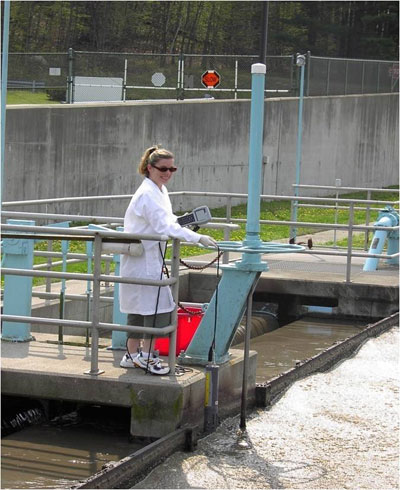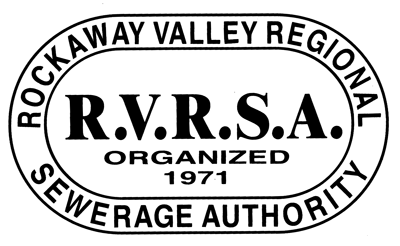Laboratory
Laboratory
Certified Laboratory at RVRSA
NJDEP Certification N° NJ14384
The primary objective of the RVRSA Certified Laboratory is to determine if the quality of treated effluent discharging from our wastewater treatment plant conforms to standards set forth by the New Jersey Department of Environmental Protection (NJDEP).
Through the New Jersey Pollutant Discharge Elimination System (NJPDES) permit, RVRSA is permitted by the NJDEP to discharge into the Rockaway River a flow of 12 million gallons per day (MGD) of treated effluent. The permit is the “regulatory mechanism used by the NJDEP to help ensure the RVRSA discharge will not harm the environment.” Additionally, an Annual Certified Parameter List is given to the laboratory with the specific analytical methods for which the laboratory is certified, corresponding to a specific parameter. Every year, the NJDEP conducts proficiency testing of all of the parameters for which RVRSA laboratory is certified to perform. Laboratory technicians at RVRSA work diligently to comply with the requirements as set forth in our NJPDES permit by conforming to required procedures, keeping accurate and current records, and maintaining a sanitary and safe working environment within the laboratory.
The NJDEP also requires all laboratories testing wastewater to adhere to tested and accepted methods of analysis, as found in the Standard Methods for the Examination of Water and Wastewater manual.
Additionally, random unannounced audits of the laboratory’s methods are conducted by the enforcement section of the NJDEP as well as the Environmental Protection Agency (EPA), to monitor for conformance of testing protocols to written standard operating procedures (SOPs), to insure accurate record keeping and to maintain a sanitized laboratory working environment. These unannounced laboratory inspections are to ensure that the RVRSA Certified Laboratory is accurate and up to date in adhering to the new standards or permit requirements.
Listed below are those parameters with the techniques used for analysis:
Parameter Technique
Parameter Technique
Fecal coliform Membrane Filter(MF), single step
Alkalinity as CaCO3 Electrometric or Color Titration
Ammonia Distillation, Titration
Biochemical Oxygen Demand Dissolved Oxygen Depletion
Carbonaceous BOD (CBOD) Dissolved Oxygen Depletion, Nitrification Inhibition
Chemical Oxygen Demand Spectrophometric Manual/Auto
Orthophosphate Ascorbic Acid, Manual Single Reagent
Phosphorus (total) Auto Ascorbic Acid Reduction
Residue – total Gravimetric, 103-105 Degrees C
Residue – filterable (TDS) Gravimetric, 180 Degrees C
Residue – nonfilterable (TSS) Gravimetric, 103-105 Degrees C, Post Washing
Residue – settleable Volumetric (Imhoff Cone) or Gravimetric
Total, fixed, and volatile solids (SQAR) Gravimetric, 500 Degrees C
Chlorine Spectrophotometric, DPD
Oxygen (dissolved) Winkler, Azide Modification
Oxygen (dissolved) Electrode
pH Electrometric
The Laboratory at Rockaway Valley RSA is also committed in preparing and educating future laboratory technicians through our Co-Op program with local colleges and universities (County College of Morris, Ramapo College, etc.). In the program we hire a prospective candidate from these institutions who will work part time, while acquiring college credits and gaining experience. The candidates must be enrolled at these institutions within a Biology, Chemistry or Environmental Sciences degree so that the students can get experience relevant to their studies. Any interested candidates may contact our offices for further information on this program.

Malgorzata and her microscope

Natalie checking ORP meter
Parameter
Fecal coliform
Alkalinity as CaC03
Ammonia
Biochemical Oxygen Demand
Carbonaceous BOD (CBOD)
Chemical Oxygen Demand
Orthophosphate
Phosphonrus (total)
Residue – total
Residue – filterable (TDS)
Residue – nonfilterable (TSS)
Residue – settleable
Total, Fixed, and volatile solids (SQAR)
Chlorine
Oxygen (dissolved)
Oxygen (dissolved)
pH
Technique
Membrance Filter (MF), single step
Electronmetric or Color Titration
Distillation, Titration
Dissolved Oxygen Depletion
Dissolved Oxygen Depletion, Nitrification Inhibition
Spectrophometric Manual/Auto
Ascorbic Acid, Manual Single Reagent
Auto Ascorbic Acid Reduction
Gravimetric, 103-105 Degrees C
Gravimetric, 180 Degress C
Gravimetric, 103-105 Degrees C, Post Washing
Volumetric (Imhoff Cone) or Gravimetric
Gravimetric, 500 Degrees C
Spectrophotometric, DPD
Winkler, Azide Modification
Electrode
Electrometric
